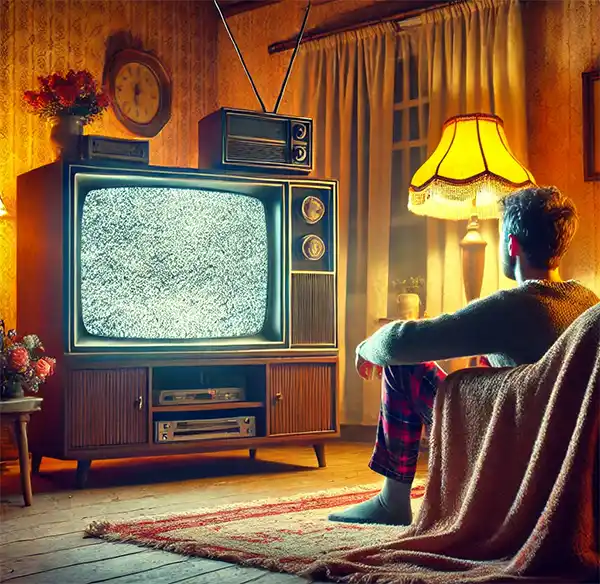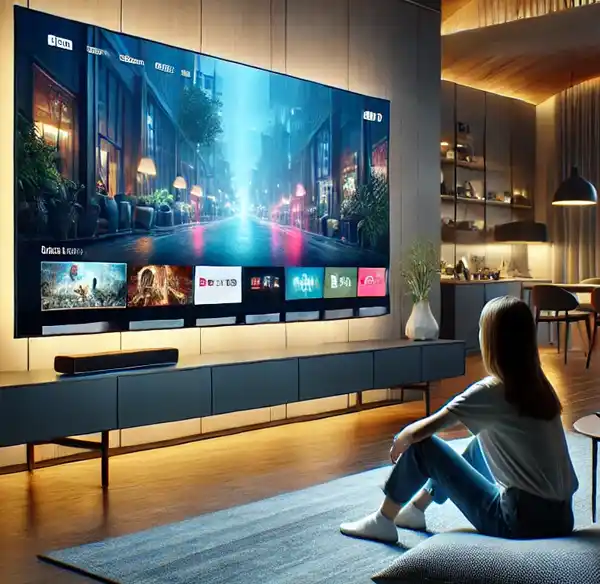From Fuzzy Screens to Crystal Clear Streams
Remember the days of rabbit ear antennas and snow-covered screens? If you’re old enough to recall smacking the side of your TV to improve the picture, congratulations—you survived the analog era. And if you ever played the "antenna acrobatics" game, where standing at a perfect angle improved the reception, you deserve a medal.
 What Was Analog TV?
What Was Analog TV?
For decades, analog television ruled the airwaves, delivering moving images through electromagnetic signals. Unlike digital signals that encode information in binary form, analog signals transmitted video and audio as continuous waves. This meant that even the slightest interference—weather conditions, nearby electrical appliances, or even the position of your furniture—could cause distortions in the picture and sound.
Watching analog TV was an adventure in patience and problem-solving. The infamous "snow" effect was a common sight, making programs look like they were being broadcast from a distant galaxy. Ghosting, where multiple overlapping images appeared on the screen, was another challenge, often caused by signal reflection. And of course, let’s not forget the ritual of adjusting the antenna, which involved everything from aluminum foil to standing on one leg in hopes of improving the signal.
Despite its flaws, analog TV had a charm that many still remember fondly. Local stations often had unique, quirky broadcasts, and there was something special about manually turning a dial to switch channels. It was an era of appointment viewing—if you missed your favorite show, you had to wait for a rerun or rely on someone else’s description.
Enter the Digital Revolution
In 2006, legislation was signed into law by President George W. Bush, requiring the switch to take place on February 17, 2009. However, the transition was later delayed to June 12, 2009, to give consumers more time to prepare. The transition wasn’t just a tech upgrade but a full-blown TV revolution. Viewers no longer had to struggle with static interference, ghosts (the TV kind, not the paranormal kind), or blurry screens. Digital TV brought high-definition images, clearer sound, and the ability to cram more channels into the same broadcast space.
In addition to improved picture and sound quality, digital broadcasting also introduced new interactive features, such as electronic program guides, multicasting, and digital closed captioning. Broadcasters could now offer multiple sub-channels on the same frequency, giving viewers more options than ever before. This meant that instead of just one channel, you could now have three or four different content streams on the same network.
The transition meant costly investments in new equipment, infrastructure, and transmission towers for television stations. While the change required some growing pains, the benefits far outweighed the costs. Digital signals also allowed for greater flexibility in content delivery, paving the way for innovations such as streaming services and on-demand programming that continue to shape how we watch TV today.
Why the Change?
The switch wasn’t just to make your favorite soap opera clearer—it freed up valuable broadcast frequencies for emergency services, mobile networks, and futuristic tech we didn’t even know we needed (hello, 5G!). Analog broadcasts took up significant portions of the radio spectrum, and digital signals use this space far more efficiently, allowing for more streamlined communication across different industries.

With the freed-up spectrum, first responders gained access to dedicated channels for emergency communication, ensuring clearer and more reliable transmissions during crises. Meanwhile, telecommunications companies benefited from expanded bandwidth, which helped lay the foundation for modern mobile networks, improving internet speeds and connectivity across the country.
Additionally, digital broadcasting eliminated many of the inefficiencies of analog signals, such as quality degradation over long distances. With digital TV, as long as you received a signal, you got a crystal-clear picture—no more adjusting antennas to reduce static. This change was particularly beneficial for rural and remote areas, where analog reception was often spotty at best.
The Scramble for Converter Boxes
When the switch was announced, millions of TV owners with older sets faced a dilemma—buy a digital TV or snag a converter box. The government even issued coupons to help transition electronics stores into battle zones as people rushed to claim their digital lifeline. It was the 2009 equivalent of trying to buy a PlayStation 5 on launch day.
Many consumers found themselves overwhelmed with questions. Would their beloved tube TVs suddenly turn into expensive paperweights? Could they still watch their favorite shows without upgrading to a costly new set? The answer was the converter box—a small but mighty device that translated digital signals into a format older TVs could understand.
While some embraced the change, others struggled with setup, leading to a flurry of customer service calls and frustration. The transition also sparked a nostalgia-fueled resistance, with some households clinging to their analog TVs as long as possible. Some even swore their old TVs had “better” picture quality—probably the same people who claim vinyl sounds better than digital music. Yet, as time passed, most people adapted, realizing that the clearer picture and additional channels were well worth the effort.
The End of an Era
With analog TV signals gone, an entire generation of grainy, low-resolution broadcasts faded into history. No longer could you twist the antenna just right and catch an extra channel. Gone were the days of emergency MacGyver-like fixes, where a bent coat hanger could suddenly make the picture watchable.
For those who grew up in the analog age, the loss was more than just technical—it marked the end of a cultural phenomenon. Snowy static, vertical hold adjustments and late-night test patterns became relics of a bygone era. It was the end of a time when Saturday morning cartoons and prime-time sitcoms ruled the airwaves, and streaming services had yet to dictate what we watched and when.
However, the end of analog also signaled a new beginning. The digital age ushered in a golden era of high-definition programming, interactive viewing, and, eventually, streaming. While the transition was met with resistance, it laid the foundation for modern entertainment as we know it.
What’s Next for TV?
Today, digital TV is just the tip of the iceberg. Streaming services, smart TVs, and on-demand entertainment have taken over. We’ve gone from fighting for a clear signal to drowning in an ocean of endless content. But no matter how advanced our technology gets, one thing remains the same: No matter how many channels we have, we’ll still complain that there’s nothing good to watch.
So, as we celebrate Analog to Digital TV Day, take a moment to remember the static-filled days of old. And maybe, just for nostalgia’s sake, adjust your Wi-Fi router and pretend it’s a rabbit ear antenna. You know, for old times’ sake.
Please Share our Content






 What Was Analog TV?
What Was Analog TV?









 "Sláinte!" is a traditional Irish expression used as a toast, equivalent to "Cheers!" in English.
"Sláinte!" is a traditional Irish expression used as a toast, equivalent to "Cheers!" in English.